This article needs additional citations for verification .(October 2010) |

The 'Convention between Italy and Turkey settled in 1932 a territorial dispute between Italy and Turkey in the Aegean sea.
This article needs additional citations for verification .(October 2010) |

The 'Convention between Italy and Turkey settled in 1932 a territorial dispute between Italy and Turkey in the Aegean sea.
The Convention, signed in Ankara on January 4, 1932, by the Italian Plenipotentiary, Ambassador Pompeo Aloisi, and the Turkish foreign minister Tevfik Rüştü Aras, settled a dispute that had arisen in the aftermath of the Treaty of Lausanne of 1923, about the sovereignty over a number of small islets and the delimitation of the territorial waters between the coast of Anatolia and the island of Kastellórizo, which had been an Italian possession since 1921.
Through the convention, the islets situated inside the bay of the harbour of Kastellorizo, along with the islands of Rho and Strongili further off, were assigned to Italy, while all other islets in the surrounding area were assigned to Turkey.
The names in italian and Turkish languages in the area around the Bodrum area (of the western Anatolia peninsula) are shown in the following section:
| Border Protocol of 1932 Demarcation line | ||
 | ||
| Geographical points Turkish side | ||
| Point | Name in text | Modern name |
|---|---|---|
| A | Mordala I. | |
| B | Kara Ada | Kara Ada |
| C | Guirejik I. | Gürecik Adası |
| D | Utchian I. | Kargı Adası |
| E | Arkialla Pt. | |
| F | Hussein Pt. | Hüseyin Burnu |
| G | Lodo | Yassıada |
| H | Atsaki | Topan Adası / Zouka |
| I | Kato I. | Çavuş Adası |
| J | Pondikusa | Büyükkiremit Adası |
| K | Sandama Peninsula | İnce Burnu |
| L | C. Monodendri | Tekeağaç |
| Italian (later Greek) side | ||
| Point | Name in text | Modern name |
| A | C. Phuka | Ag. Fokas |
| B | Luro Pt | Akr. Psalidi |
| C | Kum Pt. | Akr. Ammoglossa |
| D | C. Russa | Akr. Roussa |
| E | Vasiliki Pt. | Vasiliki |
| F | Karapsili Pt. | Akr. Atsipas |
| G | Kardak (Rks) | Imia/Kardak |
| H | Kalolimno | Kalolimnos |
| I | Agia Kiriaki | Ag. Kiriaki |
| J | Pharmako | Farmakonisi |
| Source: Text of the 1932 treaty and border protocol, and modern maps of the area. | ||
Moreover, the Italian Government recognised the sovereignty of Turkey over the Aegean islet of Kara Ada (Greek: Arcos), situated in front of the town of Bodrum.
In an Appendix signed in December of the same year, the two countries agreed to extend the convention delimiting the sea border between the Anatolian coast and the Italian Dodecanese. This was done by defining thirty five points which were equidistant between Italian and Turkish territory (some are shown in image below).
The validity of the appendix became a political issue in the context of the Aegean dispute in 1996, after the Imia/Kardak crisis. The Turkish government has rejected it as legally invalid, on the grounds that it was not deposited at the League of Nations in Geneva. This, according to the Turkish view, means that the sovereignty over an unknown number of small islets and rocks in the Dodecanese may be still undefined. However, the validity of the convention itself, with respect to Kara Ada and the Kastellórizo region, is not under dispute.
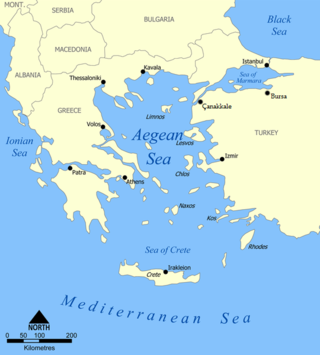
The Aegean Sea is an elongated embayment of the Mediterranean Sea between Europe and Asia. It is located between the Balkans and Anatolia, and covers an area of some 215,000 square kilometres. In the north, the Aegean is connected to the Marmara Sea, which in turn connects to the Black Sea, by the straits of the Dardanelles and the Bosphorus, respectively. The Aegean Islands are located within the sea and some bound it on its southern periphery, including Crete and Rhodes. The sea reaches a maximum depth of 2,639m to the west of Karpathos. The Thracian Sea and the Sea of Crete are main subdivisions of the Aegean Sea.
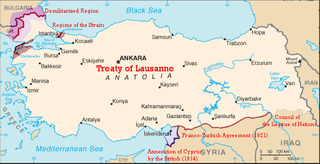
TheTreaty of Lausanne is a peace treaty negotiated during the Lausanne Conference of 1922–23 and signed in the Palais de Rumine, Lausanne, Switzerland, on 24 July 1923. The treaty officially settled the conflict that had originally existed between the Ottoman Empire and the Allied French Republic, British Empire, Kingdom of Italy, Empire of Japan, Kingdom of Greece, Kingdom of Serbia, and the Kingdom of Romania since the onset of World War I. The original text of the treaty is in French. It was the result of a second attempt at peace after the failed and unratified Treaty of Sèvres, which aimed to divide Ottoman territories. The earlier treaty had been signed in 1920, but later rejected by the Turkish National Movement who fought against its terms. As a result of the Greco-Turkish War, Izmir was retrieved and the Armistice of Mudanya was signed in October 1922. It provided for the Greek-Turkish population exchange and allowed unrestricted civilian, non-military, passage through the Turkish Straits.
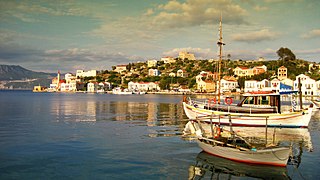
Kastellorizo or Castellorizo, officially Megisti, is a Greek island and municipality of the Dodecanese in the Eastern Mediterranean. It lies roughly 2 kilometres off the south coast of Turkey, about 570 km (354 mi) southeast of Athens and 125 km (78 mi) east of Rhodes, almost halfway between Rhodes and Antalya, and 280 km (170 mi) northwest of Cyprus. Kastellorizo is part of the Rhodes regional unit.
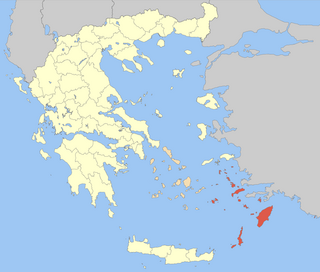
The Dodecanese are a group of 15 larger plus 150 smaller Greek islands in the southeastern Aegean Sea and Eastern Mediterranean, off the coast of Turkey's Anatolia, of which 26 are inhabited. This island group generally defines the eastern limit of the Sea of Crete. They belong to the wider Southern Sporades island group.

Relations between Greece and Turkey began in the 1830s following Greece's formation after its declaration of independence from the Ottoman Empire. Modern relations began when Turkey declared its formation in 1923 following the defeat of the Ottoman Empire in World War I.

The Aegean Islands are the group of islands in the Aegean Sea, with mainland Greece to the west and north and Turkey to the east; the island of Crete delimits the sea to the south, those of Rhodes, Karpathos and Kasos to the southeast. The ancient Greek name of the Aegean Sea, Archipelago was later applied to the islands it contains and is now used more generally, to refer to any island group.
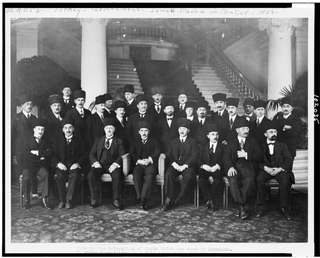
The Conference of Lausanne was a conference held in Lausanne, Switzerland, during 1922 and 1923. Its purpose was the negotiation of a treaty to replace the Treaty of Sèvres, which, under the new government of Mustafa Kemal Atatürk, was no longer recognized by Turkey.

An exclusive economic zone (EEZ), as prescribed by the 1982 United Nations Convention on the Law of the Sea, is an area of the sea in which a sovereign state has special rights regarding the exploration and use of marine resources, including energy production from water and wind. It stretches from the outer limit of the territorial sea out to 200 nautical miles (nmi) from the coast of the state in question. It is also referred to as a maritime continental margin and, in colloquial usage, may include the continental shelf. The term does not include either the territorial sea or the continental shelf beyond the 200 nautical mile limit. The difference between the territorial sea and the exclusive economic zone is that the first confers full sovereignty over the waters, whereas the second is merely a "sovereign right" which refers to the coastal state's rights below the surface of the sea. The surface waters are international waters.

The Aegean dispute is a set of interrelated controversies between Greece and Turkey over sovereignty and related rights in the region of the Aegean Sea. This set of conflicts has strongly affected Greek-Turkish relations since the 1970s, and has twice led to crises coming close to the outbreak of military hostilities, in 1987 and in early 1996. The issues in the Aegean fall into several categories:
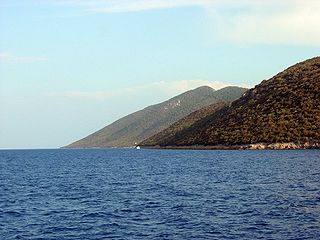
Kara Ada,, is a small Turkish island at the entrance of the harbor of Bodrum in the Aegean Sea. It is a popular tourist destination, particularly for yachting.

Ro or Rho is a small Greek island in the eastern Mediterranean Sea, more precisely in the Levantine Sea, near Kastellorizo, close to the Turkish coast. It is part of the municipality of Megísti (Kastellorizo) in the South Aegean region.

Kastellorizo is the easternmost Greek island and is situated in the Eastern Mediterranean. It lies about 2 miles (3 km) from the Anatolian coast (Lycia), more or less halfway between Rhodes and Antalya.

The Italian Islands of the Aegean were an archipelago of fourteen islands in the southeastern Aegean Sea, that—together with the surrounding islets—were ruled by the Kingdom of Italy from 1912 to 1943 and the Italian Social Republic from 1943 to 1945. When the Kingdom of Italy was restored, they remained under formal Italian possession until they were ceded in the Treaty of Peace with Italy, 1947 to Greece in 1947.

Italy-Turkey relations are the relations between Italy and Turkey. Both countries are members of NATO and the Union for the Mediterranean and have active diplomatic relations. Italy is a member of the European Union, Turkey is not a member.
Imia is a pair of small uninhabited islets in the Aegean Sea, situated between the Greek island chain of the Dodecanese and the southwestern mainland coast of Turkey. They are known in Turkey as Kardak.
The Treaty of Athens between the Ottoman Empire and the Kingdom of Greece, signed on 14 November 1913, formally ended hostilities between them after the two Balkan Wars and ceded Macedonia—including the major city of Thessaloniki— most of Epirus, and many Aegean islands to Greece.
The Italian occupation of Adalia, city of Turkey, occurred in the turbulent times after the dismemberment of the Ottoman Empire that led to the Treaty of Sèvres.

The borders of Greece have changed nine times since the Protocol of London on March 22, 1829 until the accession of the Dodecanese in 1947.